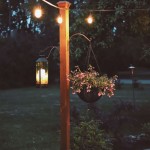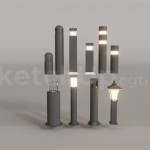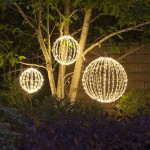What Is The Best Material For Outdoor Lighting?
Outdoor lighting plays a crucial role in enhancing both the aesthetic appeal and security of any property. From illuminating pathways and gardens to showcasing architectural features, the right outdoor lighting can transform a space. Selecting the appropriate material for your fixtures is essential to ensure they withstand the elements and provide long-lasting performance. This article delves into the most common materials used in outdoor lighting, highlighting their strengths and weaknesses to guide you in making informed decisions.
Aluminum: Lightweight and Durable
Aluminum is a popular choice for outdoor lighting due to its lightweight nature, exceptional durability, and resistance to corrosion. Its inherent strength makes it ideal for creating intricate designs and complex shapes, allowing for a wide range of styles. Aluminum's resistance to rust and weathering ensures longevity even in harsh environmental conditions. Furthermore, its ability to be easily painted or powder-coated offers versatility in matching the aesthetic of your property.
Aluminum's primary drawback is its susceptibility to dents and scratches if subjected to rough handling. However, its lightweight nature makes it easier to handle during installation, minimizing the risk of damage. Overall, aluminum offers an excellent combination of strength, durability, and aesthetic appeal, making it a highly suitable material for outdoor lighting fixtures.
Stainless Steel: Superior Corrosion Resistance
Stainless steel is renowned for its exceptional corrosion resistance, making it a top contender for outdoor lighting, particularly in coastal environments. Its high strength-to-weight ratio allows for sturdy fixtures that can withstand harsh weather conditions and extreme temperatures. Stainless steel is highly resistant to rust and discoloration, ensuring its appearance remains pristine over time. Additionally, it can be polished to a mirror finish, adding a touch of elegance to your outdoor lighting.
The main drawback associated with stainless steel is its higher cost compared to other materials. However, its exceptional durability and longevity often outweigh the initial investment, making it a worthwhile choice for long-term outdoor lighting solutions. Stainless steel is particularly suitable for applications where resistance to corrosion is paramount, such as coastal areas, industrial settings, and environments with high salt content.
Copper: Timeless Elegance and Durability
Copper has a rich history in lighting, known for its unique aesthetic appeal and inherent durability. Its warm, earthy tone adds character and sophistication to any outdoor space. Copper's natural patina develops over time, creating a distinctive and elegant finish. Its excellent electrical conductivity and low resistance to corrosion ensure optimal performance and long-lasting functionality.
While copper is more expensive than aluminum or stainless steel, its unique aesthetic properties and inherent durability make it a worthwhile investment. Copper lighting fixtures can withstand the harsh outdoor environment and continue to enhance the beauty of your property for many years to come. Copper's warm glow and timeless appeal make it a perfect choice for traditional and rustic designs.
Plastic: Affordable and Versatile
Plastic has emerged as a popular material for outdoor lighting due to its affordability and versatility. It is lightweight, easy to mold into various shapes and designs, and available in a wide range of colors. Plastic is also resistant to weathering and UV damage, making it suitable for outdoor applications. Furthermore, its low cost makes it an attractive option for budget-conscious homeowners.
However, plastic is less durable than other materials like aluminum or stainless steel. It can crack or break under extreme impact or temperature fluctuations. Additionally, plastic is not as aesthetically pleasing as other materials and may lack the durability required for high-traffic areas.
Glass: Adding a Touch of Glamour
Glass is often incorporated into outdoor lighting fixtures to add a touch of elegance and sophistication. Its ability to diffuse light creates a warm and inviting atmosphere. Glass can be clear, frosted, or textured to achieve different lighting effects. However, glass is a delicate material and prone to breakage. Therefore, it is typically used in combination with other materials, such as metal or plastic, for added strength and durability.
When choosing glass for outdoor lighting, it's essential to select tempered or thick glass to minimize the risk of breakage. Additionally, consider the location of the fixtures and ensure they are positioned in areas where they are less susceptible to impact.
The best material for outdoor lighting depends on a range of factors, including budget, design preferences, the surrounding environment, and desired functionality. By carefully considering the strengths and weaknesses of each material, you can select the most suitable solution for your needs.

What S The Best Material For Your Outdoor Lighting Fixtures

11 Deck Lighting Ideas For Illuminating Your Outdoor Space Bob Vila

19 Stylish Outdoor Lighting Ideas The Best Patio

How To Light Your Patio Or Yard Without Annoying Neighbors The New York Times

The Best Solar Path Lights Of 2024 According To Testing Bob Vila

Exterior Wall Lights At Light11 Eu

Outdoor Lighting Guide Delmarfans Com

19 Stylish Outdoor Lighting Ideas The Best Patio

Outdoor Lighting Guide The Home Depot

Best Outdoor Solar Lights 2024 Forbes Vetted
Related Posts







